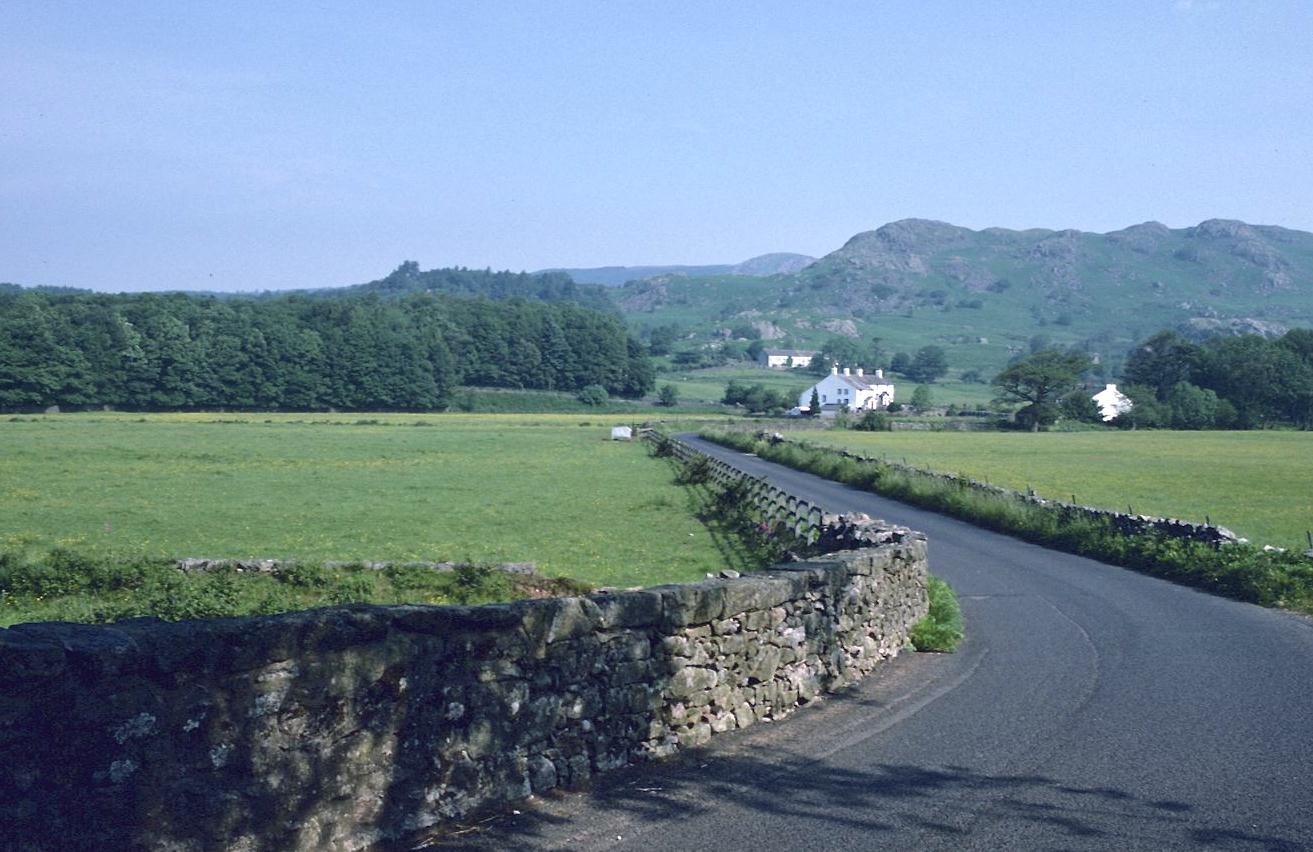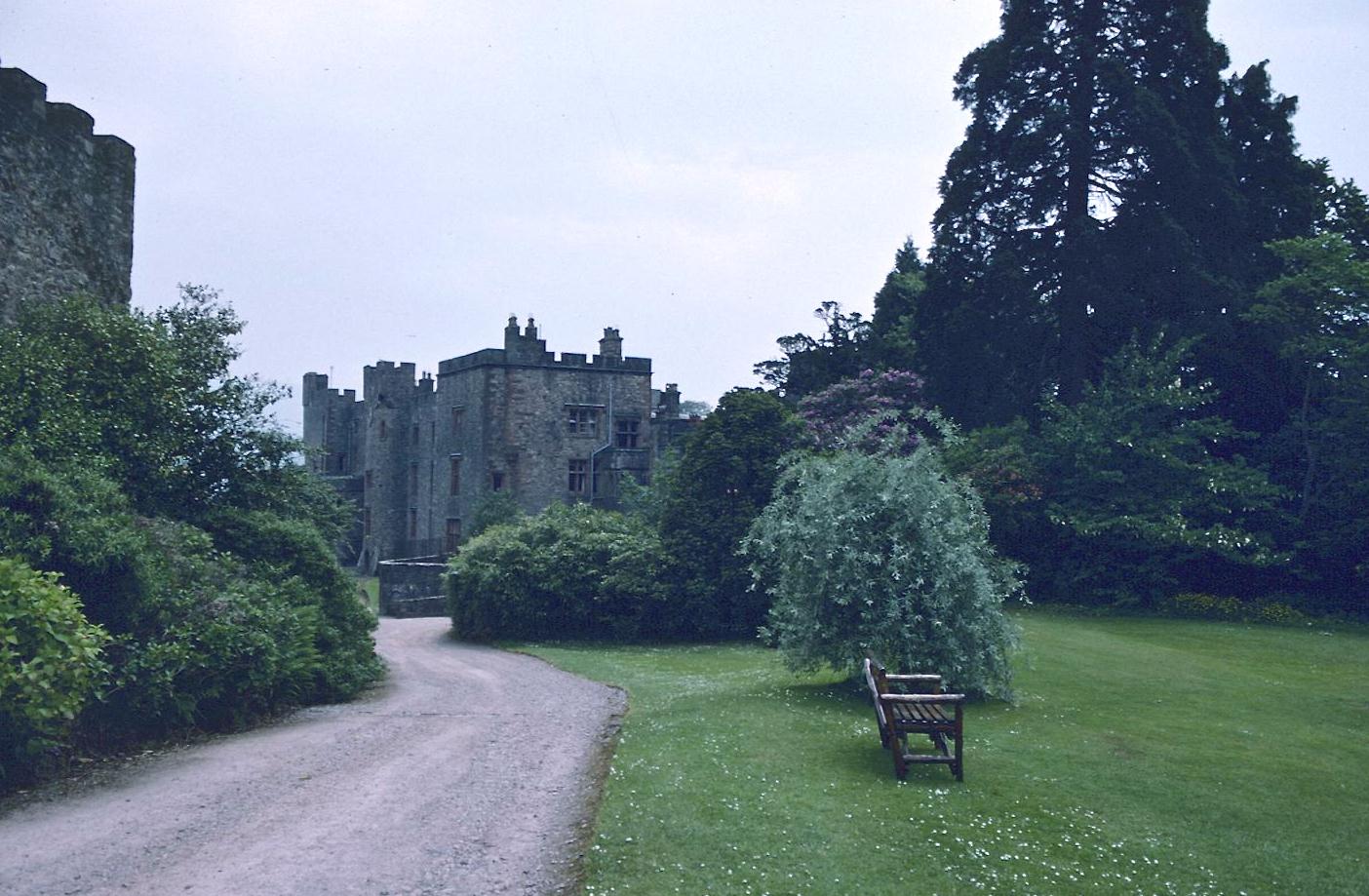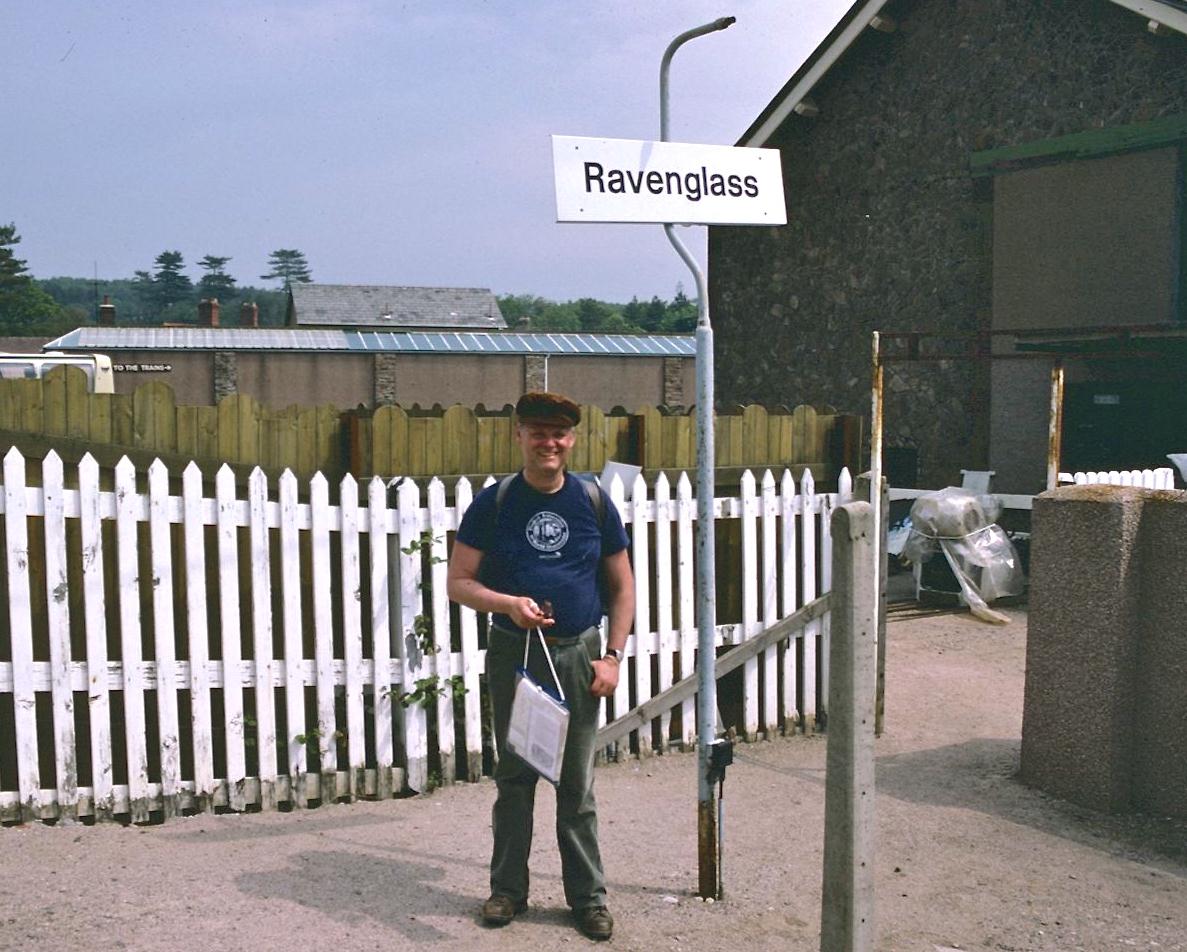June 27, 1986: Boot to Ravenglass
It was the last day of our walk. Tosh had already left Boot 40 minutes before Harold and I met for our breakfast in the Brook House dining room. (She had been the sole passenger on the 7:20 train from the nearby Dalegarth station.) I too wanted an early start because Harold and I, who would now be walking the last eight miles to Ravenglass, needed to do so in time to catch a 2:20 train. We received our packed lunches and paid up and at 8:40 we were ready to go.
The first half-mile, down the lane to the church, past the bellowing cattle and over the stepping stones, was a repeat of yesterday’s arrival route. We continued up Birker Beck, found our old track, and turned right. We then followed this track, in its many variations, for two miles as we headed west – with the Esk, sometimes close, sometimes far, on our right. Most of the time we were walking in woods, which was just as well because it was hot again and sunny. The wonderful piney smell reminded both of us of California.
After Dalegarth House we were seduced into taking a left uphill fork. It was the dominant surface on the ground at this point, but it soon petered out as we continued somewhat south of the woods in open fields dissected by stone walls. As we neared the last of these, and saw only wall ahead, an old hump-backed man, mending one of the crossing walls, chuckled at us and told us we’d have to use the gate at the north end of his field to escape back to our woodland path. This gate saved us a bit of backtracking and we were soon on course, leaving the woodland to sit and rest on some cliffs above the river. Unfortunately we were beset by flies and other insects and it seemed more comfortable to keep going. At the access road to Milkingstead I noticed that we had clocked off two 25-minute miles – quite a pace for us.
We paused again briefly before crossing Forge Bridge, our last glimpse of the Esk, and walked on macadam in the hot morning sun up to the King George IV pub – where we turned left at the crossroads onto the metaled road to Eskdale Green. We could hear a train pulling into the station there and we waited for it to continue its journey in open country – so I could take a picture.
Our route called for us to take a track on the south side of the road, signposted to Muncaster. This was quite clear as we passed the railway station but it became overgrown as we continued west, crossed a stream, and wound uphill to an extensive cattle-dappled field with no path at all. I pulled out my compass here and tried to orient myself by using the margins of the local woodland, as indicated on the OS map. I determined we had come far enough south and that we should look for a more westerly continuation. We followed a track north and as we did so I spotted the farmhouse at Muncaster Head. This enabled me to find a path crossing over to its access road. We could see other walkers beginning to climb Muncaster Fell. This would have been a nice option for us too, given a little less sun and little more time, but I chose to use the track that begins at Muncaster Head and traces a line along the southern foot of the Fell, with little rise or fall in elevation. (Eight years later I did have the opportunity of completing the higher route, which was outstanding.)
We began to pause frequently for liquid and rest, for it was quite hot, particularly on the open stretches of the road. Flies continued to be a problem. All of this was unfortunate because the road was quite delightful – choked with wildflowers in profusion, including the rhododendrons which have run wild in many corners of the Lake District – and offering fine views of the lower Esk Valley on our left.
We passed High Eskholme and started to look for our next turnoff. The signs we were looking for appeared as expected, but what was not anticipated was that the right of way would now lead across a golf course! We kept to the edge of a wood as we turned southwest. Two lads, combing a bunker with rakes, looked surprised to see us march off the green between tall rhododendron bushes. “All right?” one called in greeting. There wasn’t much evidence of path for a while, but then I picked up a track that put us on the access road to Low Eskholme. We turned right here, amid timber operations and smoke, and reached, at a crossroads, the actual end of the metaled High Eskdale road – the one we had been floundering about to avoid walking on in the first place.
There was a strong impetus to follow a line of hurtling cars down the hill toward Esk Bridge, but a long minute spent with compass and OS map convinced me that we were meant to go right into a long northwesterly curve and climb a hill in order to reach Muncaster. Near the top of this we collapsed at the roadside and watched the struggling cyclists behind us. When we resumed I was surprised to discover that a short descent brought us to a back entrance to Muncaster Castle itself. This we used, reaching the garden center at 10:50. We each had an ice cream, purchased from a kindly woman who was genuinely disappointed to find out that were not here to see the castle or its grounds.
We approached the castle itself and sat down to have something to drink at the cafe next door. The day was just beginning here – with a sweeping of the courtyard and an unshuttering of the gift shop windows. My intention, since we were making such swift progress, was to spend some time in a Ravenglass pub – so we paused only for a few minutes at the duck pond, crossed its northern tip and located the signed track to Dovecot Wood, the escape route recommended by Dunn.
Flies were still a problem but the skies were becoming a little more overcast and there was some relief from the heat. At the top of the hill a footpath sign to Newtown pointed bravely across an empty moorland, but there was no evidence of a path. I took a bearing and headed for a woods on the opposite side. When we reached the broken stone wall that surrounded these trees there was no evidence of any way forward at all. The wall was easily breached in a number of places and we climbed over near a huge tree stump, pausing to rest and figure out our next move. I had the impression that much had changed recently. Logging was going on in the woods and a forestry track wound down to cross a stream and ascend the opposite bank. We followed this and had a peak at the landscape to the west. Nothing computed until I spotted a line of pylons crossing our line of vision at right angles. I decided we needed to go south on the forestry track, so we followed it, soon seeing Newtown on our left (this farm would have made a much better target than the forestry wall – as I discovered in 1994). From Newtown a track headed west under the pylons, as advertised.
In a just a few minutes we reached a tarmaced track heading north and already in view was Walls Castle, surrounded by rhododendrons. We were looking for a place to eat when Harold said, “Your stick is missing.” Indeed I had been walking without my famous horn handled cane for who knows how long. My initial hope was that it had been left at one of our recent rest stops so (checking my watch) I decided to go back and see. Harold was left with my gear and I went charging off back under the pylons and up the forestry track, checking to see if I had left it at the spot where we had breached the wall. There was no sign of it and there were too many other possible spots where it might have been left (the café at Muncaster Castle, for instance) for me to attempt any further rescue. It was gone and I was quite upset. The only dividend for this extra mile or so was that I saw a young deer crossing the forestry track as I returned.
When I rejoined Harold at Walls Castle I pulled a can of Lilt from the side pocket of my pack, for I was quite parched. I drank from this as we walked up to Ravenglass. We were following a young courting couple whose busy hands showed that they were quite oblivious to our presence behind them. A footpath sign pointed to a little track through a park and out to the railway line, where we could see the mainline station and, on our right, the Eskdale and Ravenglass terminus. Harold made a few inquiries and we ended up doing our waiting at the narrow gauge station, only because there was some shade here. The sun was quite hot again. It was 1:40.
We decided not to go to the Ratty Arms – as I was still drinking the last of my Lilt. We ate a little food and at 2:25 went over to the mainline station to wait for the coastal shuttle. Here an ordeal began. We bought through tickets for London from a chap who looked just like Emmerdale’s Alan Turner but the train, which was stifling hot and crowded, stopped an hour later in the middle of nowhere for twenty minutes and I could see we would miss our connection at Preston. We tried to switch to the main line at Lancaster but, at 4:45, we had missed a decent connection here. I phoned Dorothy and we then sat on the platform until 6:05 – only to be told that the train we wanted was 25 minutes late because of a derailment at Lockerby earlier in the week. At 6:30 we finally boarded this train, riding only as far as Preston. There was no London train here either but we jumped on one headed for Crewe, hoping to improve our chances. Here we expected to wait for a Euston connection but we were seduced by the departure of a Paddington train. We hopped aboard, but this was a stopping train that called at a dozen stations, including Birmingham and Oxford. There was no food and we ate everything in our packs except a few hard candies. I did have some gin. The train did not reach London until shortly before midnight – we were three and a half hours late. Harold and I said goodbye here and I took a cab home – with Dorothy and Toby still up to welcome me.
So, we had finished the Roman Way – it was the first time, but not the last, that I would complete an entire route in one trip. We had enjoyed our outing very much.
Footpath Index:
England: A Chilterns Hundred | The Chiltern Way | The Cleveland Way | The Coast-to-Coast Path | The Coleridge Way | The Cotswold Way | The Cumberland Way | The Cumbria Way | The Dales Way | The Furness Way | The Green London Way | The Greensand Way | The Isle of Wight Coast Path | The London Countryway | The London Outer Orbital Path | The Norfolk Coast Path | The North Downs Way | The Northumberland Coast Path | The Peddars Way | The Pennine Way | The Ridgeway Path | The Roman Way | The Saxon Shore Way | The South Downs Way | The South West Coast Path | The Thames Path | The Two Moors Way | The Vanguard Way | The Wealdway | The Westmorland Way | The White Peak Way | The Yorkshire Wolds Way
Ireland: The Dingle Way | The Wicklow Way
Scotland: The Great Glen Way | The Rob Roy Way | The Speyside Way | The West Highland Way
Wales: Glyndwr’s Way | Offa’s Dyke Path
Channel Islands: The Guernsey Coastal Walk | The Jersey Coastal Walk



